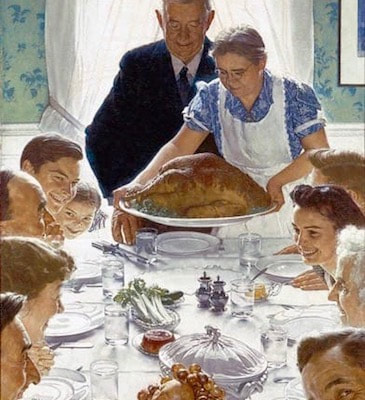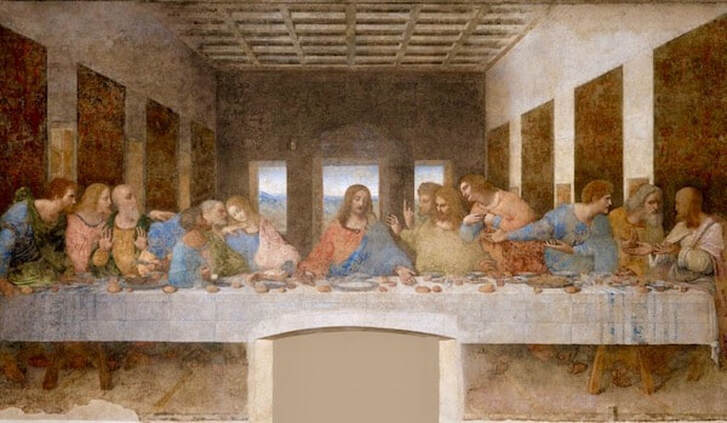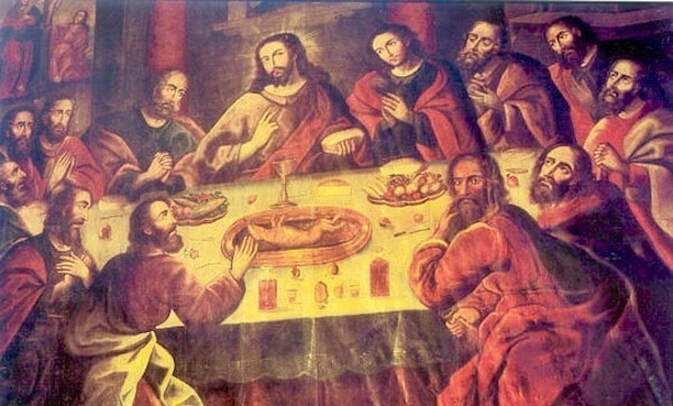|
There were tablecloths before there were dining tables. There were dining tables before there were dining rooms - but they were just called cloths, tables or trestles. Above, a French damask, ecru cloth, and going by the monogram design, I'd say it was c.1930. When I found it, it had never been used. At the end of the evening, the cloth has taken a beating. But it's only superficial. It will survive. It will be cleared the following day (we clear the next day in our household) and rejuvenated. If you spill something, don't apologise. That puts me in an awkward position of having to reassure you that it doesn't matter. Trust me, it doesn't matter. I will be washing it later and ironing it before it's used again. (And please use your napkin, vigorously if you will, and discard it casually at the end. If it's still neatly folded, trust me, I won't be putting it back in the drawer.) A cri de cœur... Please don't sprinkle salt. It's a myth that it neutralises a stain. It just makes a nasty gritty surface for the rest of the meal. One time, a guest brought to dinner a new girlfriend who rose from her chair and poured salt on the wine spill of another guest!!! (They are no longer seeing each other.) A cloth gives a nice warmth and softness under-hand, especially if there's a spongy under-cloth. It also deadens noise. Over the years I've collected table cloths or rather, I've rescued them. It's not a virtue, it's just what I do. Sometimes, there have been small circular holes in them - cigarette burns, probably, and this adds to their mystery. I mend them and ponder the bad old days when people smoked (even at table, and that's another story). "The past is another country: they do things differently there." ( L.P. Hartley- The Go-Between. ) Washing and Ironing
There are linens out there that are rustic and creased. Fine, it's a look, go for it. Left: Banquet, Willem Claesz Heda, Dutch, 1635 (Nat. Gallery of Art, Washington DC) Right: 21st century. Crumpled can be good. History Of The Cloth Left: Wedding Feast, Pieter Bruegel, 1556 - cloth, just covering trestles.
Centre: Friends' very elegant table, placemats, keeping us in place. Right: Freedom From Want, Norman Rockwell, 1943 Not every dining table has a cloth, especially if you're showing off some wood or marble. But the tablecloth is a signifier, it signifies the intention to eat. The Romans started putting cloths under food around 2030 years ago. When there was food to be eaten, down went a cloth, be it on the ground or across a board or trestle. (Think boardroom, chairman of the board, sideboard etc.) Cloths weren't ironed but folded into presses. This lead to artfully creased cloths, the folds much prized. (See "The Last Supper", previous post.) Place settings weren't delineated. Food was placed on the cloth for picking at. In Europe during the middle ages, seating began to be marked by a trencher, a piece of bread, but still spoons and drinking vessels were shared. 17th C Dutch paintings show rich, well dressed burghers or traders (i.e. business men) talking at tables, sharing from a few glasses, expensive items embellished in the Venetian style. When knives started to be used to eat with, bread trenchers were replaced by metal or ceramic. Privacy became "a thing" and people chose to eat in smaller groups and the 18th C saw a drawing away into small eating or dining rooms - then to especially made tables. Cloths were ironed smooth. Gradually decorum ruled that each person be segregated, one from the other, with a place setting, our little section, our own little armoury of cutlery and a bevy of glassware. (Incidentally, the Victorians did not cover their dining-table legs with a cloth because they looked too sexy. It was simply the fashion.) You might never look at a tablecloth in the same way again.
9 Comments
The Last Supper - Plautelli Nelli, 1568 - Florence, Santa Maria Novella Oil on canvas - 7 metres long x 2 metres high "Extract" before and after restoration. This beautiful painting appeals to me immediately through two of my obsessions - the tablecloth and the gathering together to share. Plautelli Nelli entered the convent of Santa Caterina where she established a painting workshop. It was a recognised art centre of Florence, financially supporting the convent through commissions from both private individuals and religious institutions. As a woman, she was in a sense freer than if she'd lived outside the convent, not free to be an apprentice, but self-taught and free to choose to paint. Such a large canvas, its figures life-sized, painted for the convent's refectory, was possible due to the efficiency of their enterprise allowing for teams of painters and extensive scaffolding and infrastructure. See the link for the story of how it was recently found, hanging above the Laminex table in the monks' dining room, at the back of the Museum of Santa Maria Novella. first-last-supper-woman-painter-florence The iconic biblical scene follows a standard pattern. The apostles (guests) sit along one side of the table with bad boy Judas singled out on the other side, clutching his money. Jesus has just announced that one of his apostles will betray him that evening. They gesticulate in horror, surprise and denial. As usual, John (later "Saint") is mooning, doe-eyed at Jesus. When questioned, Jesus reveals his betrayer will be the one putting his hand to the food at the same time as himself. Here Jesus and Judas are grappling for the same biscotti. In many "Last Suppers", Judas is seen to have spilt the salt, a bad omen, a definite no-no. This is a contemporary depiction of the table but the food of Christ's era would have been similar to that of the Italian peninsula. The fruit and vegetables of the New World, the Americas, would not have yet penetrated 16th century Florence. The meal is to be picked at (roasted lamb, salad, fava beans, herbs, bread, salt and wine). There are no plates, no individual place settings, no napkins. The glasses are random and shared. (Perfectly pleated tablecloth.) And, as a Jewish friend reminded me, as it was a Passover supper, 2000 years ago, there would have been no bread rolls, only un-leavened bread. Leonardo da Vinci's "Last Supper" of 1495 offered a template for years to come. The Last Supper - Leonardo da Vinci, 1495 -Santa Maria delle Grazia, Milan Guests sit on one side, looking out. Once again, John is passively dejected. Judas is apart but not so ostracised (he has tipped over the salt) and he is diving for a platter as Jesus goes for it with his right hand. The food is quite spartan, compared to the Plautelli Nelli painting (above) and the spread below. Could it just be the different feminine viewpoint? (The tablecloth shows its folds. There is some blue embroidery at each end, with a knot to shorten it from the floor.) The Last Supper - Marcos Zapata, 1753 - Cuzco Cathedral, Peru Zapata was an indigenous painter (Inca). The seating is circular. John is mooning as usual and Judas is looking at us defiantly, clutching the cash. Once again there are no individual plates, no cutlery. In the centre of the table is a roasted guinea pig, (still eaten in Peru). Like the "sacrificial lamb" of other "Last Suppers", the guinea pig was the sacrificial animal for Inca ceremonies. But the accompaniments remind us of the bounty that came from the "New World". Not just a bit of lettuce but baskets of corn, potatoes, capsicum - native fruit and vegetables. (The table cloth has a nice lace trim.) And styles change, with the last supper not always a sedate line-up.  The Last Supper - Tintoretto, 1594 - Basilica di San Giorgio Maggiori, Venice Passion and dynamic action, with not only the guests in a frenzy. The "caterers" take centre stage (with help from a nice looking dog) piling on food as the guests taper into the background. (A cloth just covers a line of trestles.)  The Last Supper - Peter Paul Rubens, 1631 - Pinacoteca di Brera, Milan Action and fabrics, lovely dog, the anguish of Judas, the pining of John, and the introduction of the eucharist - no food. We know nothing really of the Holy Grail (the supposed chalice used at the last supper) but I'm sure it was not the one housed in Valencia valencia holy grail The carved red agate cup in the Valencia Cathedral is too elaborate for something supposedly used two thousand years ago in Jerusalem. (Nice tablecloth.)  The Last Supper - Benjamin West, 1786 (British American) - Detroit Institute of Art Still a topic for the 18th century, with Christ surrounded by the usual suspects. Could that be Thomas, shrouding his eyes, who would doubt that Christ had risen or Peter who would deny knowing him when questioned by guards? (Nice tablecloth.) The Sacrament of the Last Supper - Salvador Dali, 1955
National Art Gallery, Washington U.S.A. Spiritual, luminous and severely symmetrical, the guests are gathered in a dodecahedron (that's a ball made of twelve pentagonal facets, for twelve apostles, twelve months of the year, twelve hours in the day...) (Enormous cloth, pristinely folded.) Friends gathered together but what do they all have in common? Great tablecloths. More next post. |
Categories
All
|













 RSS Feed
RSS Feed
